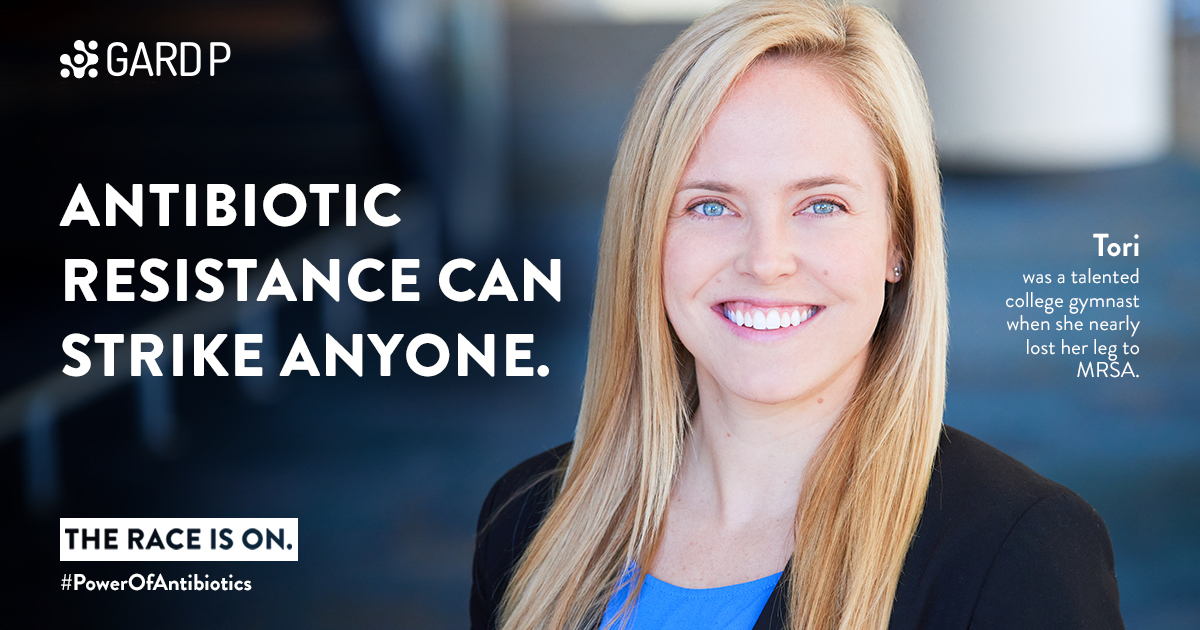From crippling infection to recovery through the power of antibiotics
Tori Kinamon was a talented 19-year-old college gymnast in the US when she felt a pain in her left hamstring. Her trainer suspected she’d strained it, while an X-ray didn’t detect anything abnormal. The student health department suggested she go home and rest.
But Tori was worried. Within days the pain was excruciating.
“It was so painful that I couldn’t walk. My leg was red and swollen. I had night sweats, a fever and my blood pressure plummeted.”
Tori phoned her mom. Concerned, she took her straight to hospital. “I think she knew something was terribly wrong,” says Tori. Doctors thought she had cellulitis and put her on broad-spectrum antibiotics. Within 24 hours she wasn’t showing any improvement.
Finally, imaging studies showed a large abscess in her hamstring muscle.
“The bacteria were in my bloodstream and then travelled to my hamstring. They set up shop there and multiplied rapidly to the point where I had an 18-centimetre abscess and an associated infection of the hamstring muscle. It was a very deep and severe infection, probably because it was not intervened upon earlier.”
Tori’s road to recovery was tough. It took a month in hospital and several surgeries to drain the wound and clear away the Methicillin-resistant Staphylococcus aureus (MRSA) infection, which is caused by a type of staph bacteria that has become resistant to many of the antibiotics used to treat ordinary staph infections.
Tori credits an effective antibiotic as being key to her eventual recovery.
“I had a great outcome because we had an extra antibiotic in the stockpile to treat my infection. It worked and I was so fortunate. It convinced me that we need to devote a lot of energy, brain power and funding to antibiotic development, especially with the threat of increasing antimicrobial resistance.
“Antibiotics are no longer a luxury that we can take for granted. It is a community, a national and international problem that we all need to be concerned about, because our lives depend on it. Mine certainly did.”
Tori also realised that antibiotics need to be tailored towards patients and their health conditions.
“It’s important to have the right antibiotic, at the right time, for the right patient because each patient responds differently to antibiotics.”
The experience has propelled Tori to do something positive.
“While in hospital, I made a commitment to myself that I was not going to be a victim of this infection. First and foremost, it meant that I was going to devote myself to research; to find out why MRSA happens, and how to prevent it. I also decided to study medicine.
“It expanded my interest in infectious disease and antimicrobial resistance. It allowed me to make meaning from my suffering. On top of that, I vowed to return to college gymnastics.”
From being unable to walk, Tori worked with a physiotherapist to regain muscle strength. Step by step, she got stronger, and returned to college gymnastics within six months…a huge achievement.
Now a qualified doctor, Tori is passionate about spreading the word about MRSA.
“MRSA infections are becoming more prevalent. As an athlete, you’re sharing surfaces; you have cuts and scrapes. Infections can happen to anyone. There is a lot of victim blame. People say: ‘If you’re clean and you shower after practice, you’re not going to get this’. But I was highly hygienic, and it happened to me.”
Tori believes reducing stigma around bacterial infections and increasing awareness and education amongst healthcare providers and patients is critical.
She has designed a curriculum to educate other college athletes about the warning signs of an MRSA infection.
“It’s important to know that if you have pain out of proportion to your injury, a red, swollen limb or joint, and you don’t feel well, trust yourself, trust your body and seek care,” she suggests.
“I’ve been on all sides of the AMR issue – as a patient, student, researcher and scientist. Ultimately, we’re all susceptible to AMR. It affects us all.”
